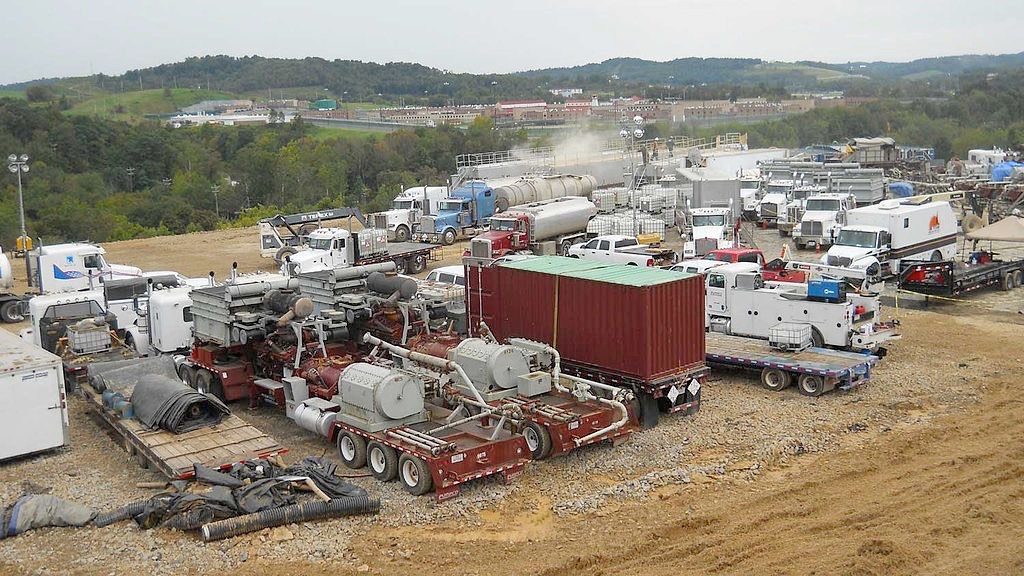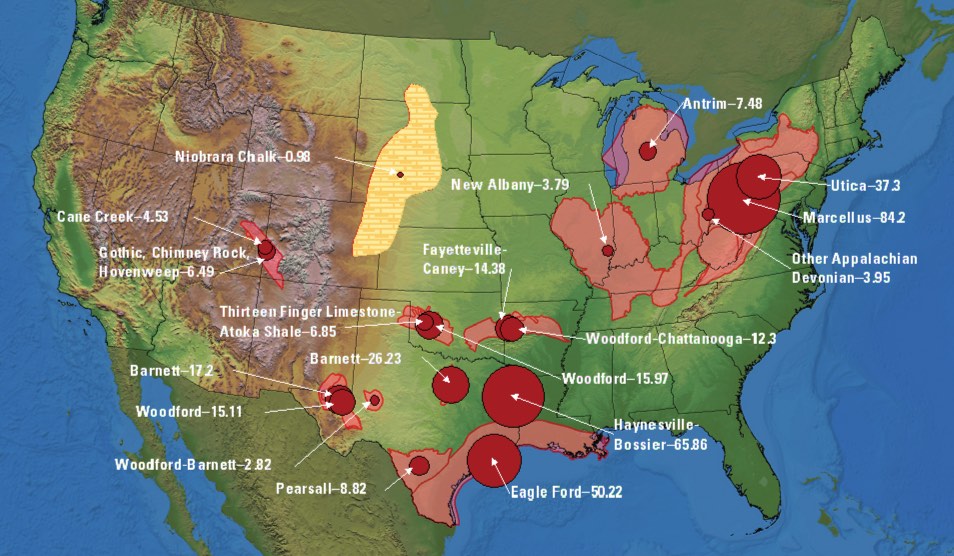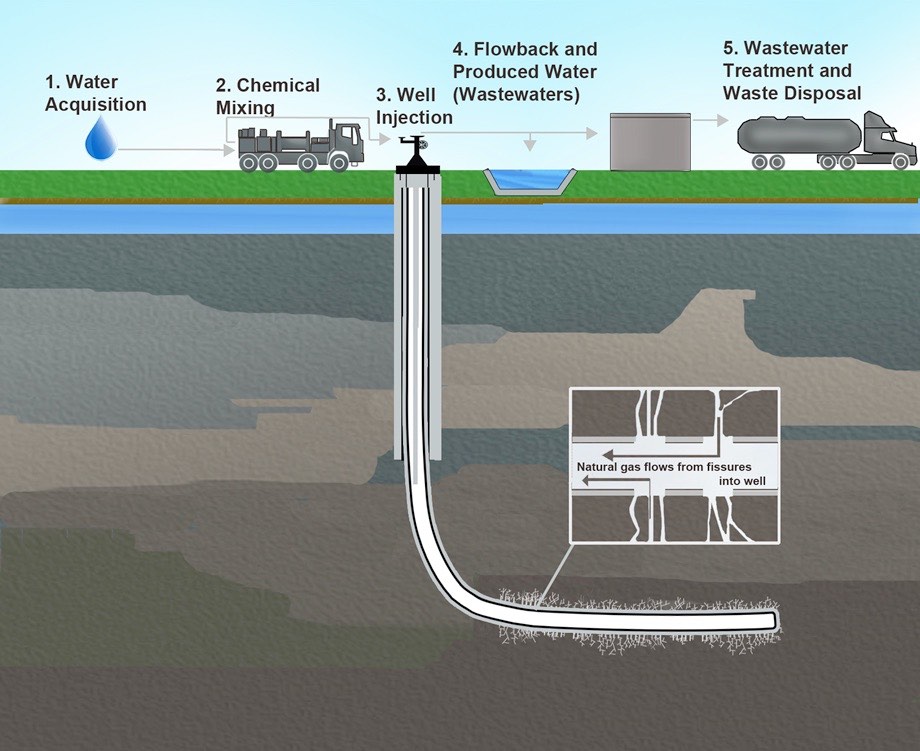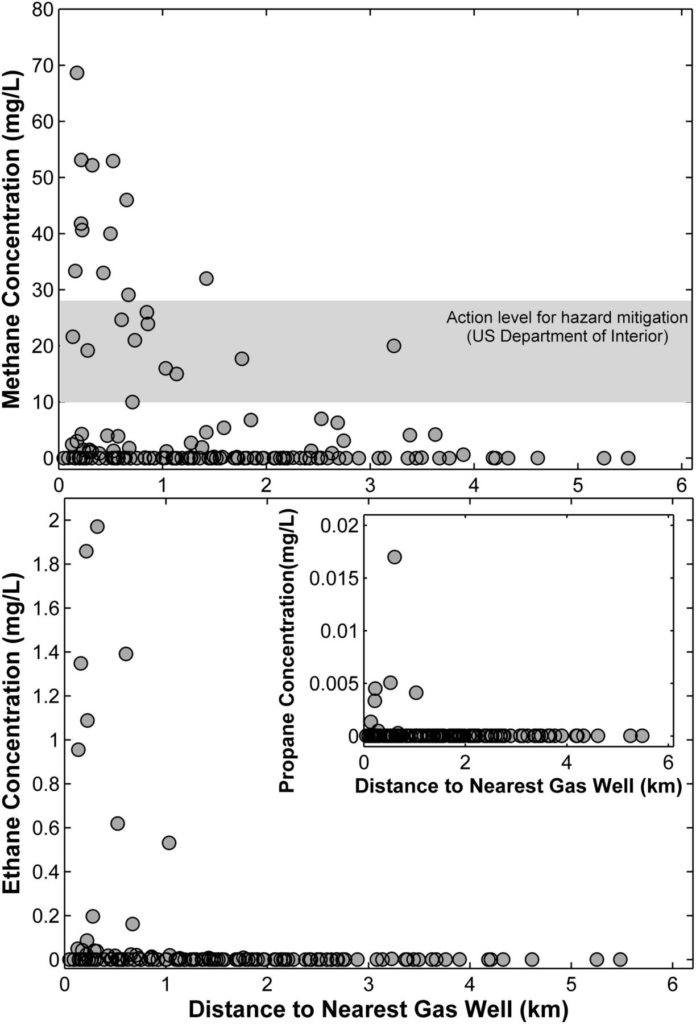Energy
3.3 Fracking’s Potential Impact on Water Quality
John A. Zagar
Hydraulic fracturing for natural gasses has become widespread in the United States, but the process also creates potential negative impacts on water quality. This process uses harmful chemicals to extract the gasses, which are often leaked into the environment through use of faulty equipment and inadequate disposal techniques.

Courtesy of U.S. Geological Survey, 2013. Public Domain.
Natural gas is the source for nearly 24% of the world’s energy.1 A great majority of these natural gas deposits are found underground in shale rock layers. One of the most notable shale rock layers in the United States is the Marcellus shale formation (Figure 2), which lies underneath New York, Pennsylvania, Ohio, and Virginia. Hydraulic fracturing (a.k.a. “fracking”) is a mechanical process by which drilling breaks open rock layers deep underground, allowing natural gas to escape to the surface to be collected. This process uses high quantities of “fracking fluids” which consist of sand, water, and a combination of chemicals pumped underground to fracture the shale rock layers containing the coveted natural gasses. Eleven to twenty-six million liters (3-7 million gallons) of water is used per fracking well during the fracking process.2 Over the past few decades new drilling technology has made gas extraction more feasible (Figure 3). However, many scientists question the safety of the process due to contamination of ground and surface water around the drilling sites.

1 Cubic Foot = 28 Liters
Courtesy of U.S. Geological Survey, 2012. Public Domain.
In 2013, researchers from the University of Missouri found that 11 of the several hundred chemicals being used in fracking fluid are known endocrine disruptors. These chemical compounds can severely damage a human’s hormonal system and are also associated with causing cancer.3 The United Nations Environmental Programme Global Environmental Alert Service (UNEP GEAS) published findings that over 75% of the 353 chemicals used in fracking fluid can negatively impact an individual’s sensory organs, respiratory system, gastrointestinal system, nervous system, immune system, and endocrine system.4 Some of the reported chemicals were even shown to be mutagenic and carcinogenic.4 There have been multiple agency reports, legal citations, and peer reviewed articles that claimed to find more gas in water wells located near areas where fracking was conducted.5 In Pennsylvania, hundreds of lawsuits have been filed against fracking companies for contaminating peoples’ water supply. In August of 2012, a major natural gas company reached settlements with 32 of 36 families suing for damages in Dimock, Pennsylvania, however numerous cases remain pending.6

Courtesy of the U.S. Environmental Protection Agency, 2012. Public Domain.
Over the past few years, there have been multiple studies published confirming that fracking sites have contaminated water quality around the drilling sites. In 2013, researchers detected methane in 82% of 141 drinking water samples found within one kilometer of shale gas wells in Northeastern Pennsylvania (Figure 4).8 Separate research teams also collected water samples located near fracking zones in Garfield County, Missouri and found an abundance of contamination caused by the fracking process.9
Tom Myers, a researcher in hydrogeology and water resources, argues that preferential flow through fractures allows for the transportation of contaminants from the fractured shale to aquifers. Myers states that there is enough substantial geological evidence to prove that natural vertical flow drives contaminants towards the surface.

Courtesy of R. B. Jackson et al., 2013.
In instances where greater amounts of methane where found in aquifers located within one kilometer of the fracking sites, Myers cites potential pathways causing this occurrence to include advection transport through sedimentary rock, fractures and faults, and abandoned wells, or open boreholes.5
The use of broken or faulty equipment is perhaps the leading source of unwanted byproducts of the hydraulic fracturing process in the water supply. In 2010, the Pennsylvania Department of Environmental Protection issued 90 violations for faulty casing and cementing and issued 119 more in 2011.8 The purpose of steel casing and cement sealing is to prevent any gasses trapped within the well from escaping into the environment. Therefore, any breaks or imperfections in the casing will enable stray gasses and chemicals to leak into the water supply.8
Studies have confirmed that the likelihood of water contamination near fracking sites is sufficiently higher than sites not near the zones. However, research conducted by Duke University and the U.S. Geological Survey have confirmed that when operated and maintained correctly, the process of hydraulic fracturing should pose no threat towards contaminating the environment around the drilling site. Researchers found no evidence of drinking water contamination in their respective studies.8
Lethargy and negligence also play a major role in the contamination of the water supply around fracking sites. Madelon Finkel and Adam Law of the American Journal of Public Health argue that states simply do not have adequate rules and regulations in regards to fracking, and that regulation of polluted water disposal is practically non-existent.6 A major byproduct of the fracking phase includes flow-back waste fluids that could potential harm the air and soil if not properly disposed. However, Finkel and Law suspect fracking companies have been secretly disposing their waste fluids into rivers and streams, many of which are sources of drinking water.6
In 2012, a study conducted by Peyton Flemming of Ceres suggested that 47% of fracking wells were erected in water basins with high or extremely high water stress, further emphasizing the need for reform on disposal regulations.10
In 2004, the U.S. Environmental Protection Agency (EPA) stated that the fracking process “pose[d] little to no threat to drinking water.” Although this statement is still supported by the EPA, the New York Times has released evidence from “whistle-blowers” within the EPA. confirming that the agency’s findings had been strongly influenced by industry and political pressure.7
Due to the “Halliburton Loophole”, many major natural gas companies have been exempt from any rules and regulations cited in the Safe Drinking Water Act of 2005. To ensure safe drinking water around drilling sites, natural gas companies need to be more regulated to prevent water contamination. So the question remains what and/or who are the main culprits causing the contamination of the water supply around fracking sites, and how can these issues be resolved?
References
- Finkel M.L., & Hays J., (2013). Public Health, 127(10):889-893
- Schmidt C.W. (2013). Environmental Health Perspectives, 121(4):117.
- Sandra Postel (2013 December 20). Hormone-Disrupting Chemicals Linked to Fracking Found in Colorado River. National Geographic, Web. Retrieved from http://newswatch.nationalgeographic.com/2013/12/20/hormone-disrupting-chemicals-linked-to-fracking-found-in-colorado-river
- United Nations Environment Programme Global Environmental Alert Service. (2012, November). Gas fracking: can we safely squeeze the rocks?. Retrieved from http://www.unep.org/pdf/UNEP-GEAS_NOV_2012.pdf
- Myers T. (2012). Groundwater, 50(6):872-882
- Finkel M.L., & Law A. (2011). American Journal of Public Health, 101(5):784-785
- Urbina I. ( 2011 March 3). Pressure Limits Efforts to Police Drilling for Gas. The New York Times. Web. Retrieved from http://www.nytimes.com/2011/03/04/us/04gas.html?pagewanted=all&_r=0
- Jackson R.B. et al. (2013). Proceedings Of The National Academy Of Sciences Of The United States Of America, 110(28):11250-11255
- Kassotis C.D., et al. (2013). Endocrinology. Early Release. doi: 10.1210/en.2013-1697
- Fleming P. (2013, May). New Study: Hydraulic Fracturing Faces Growing Competition for Water Supplies in Water-Stressed Regions. Ceres. Retrieved from http://www.ceres.org/press/press-releases/new-study-hydraulic-fracturing-faces-growing-competition-for-water-supplies-in-water-stressed-regions
- Weinhold B. (2012). Environmental Health Perspectives, 120(7):272-279
- US Geological Survey. (2013). A hydraulic fracturing operation at a Marcellus Shale well. [Photograph]. Retrieved from Wikimedia Commons. Public Domain.
- US Geological Survey. (2012). Map of Assessed Shale Gas in the United States, 2012. Retrieved from Wikimedia Commons. Public Domain.
- U.S. Environmental Protection Agency. (2012). Illustration of hydraulic fracturing and related activities. Retrieved from Wikimedia Commons. Public Domain.
- Jackson R.B. et al. (2013). Increased stray gas abundance in a subset of drinking water wells near Marcellus shale gas extraction. Proceedings Of The National Academy Of Sciences Of The United States Of America, 110(28):11250-11255. © 2013 National Academy of Science, USA.
